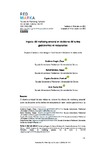Impacto del marketing sensorial en decisiones del turista gastronómico en restaurantes

Ver/
Use este enlace para citar
http://hdl.handle.net/2183/32476
A non ser que se indique outra cousa, a licenza do ítem descríbese como Atribución-CompartirIgual 4.0 Internacional (CC BY-SA 4.0)
Coleccións
Metadatos
Mostrar o rexistro completo do ítemTítulo
Impacto del marketing sensorial en decisiones del turista gastronómico en restaurantesTítulo(s) alternativo(s)
Impact of sensory marketing on food tourism decisions in restaurantsData
2022-12-16Cita bibliográfica
Gutiérrez -Aragón, O., Berbel Giménez, G., Copeiro -Fernández, M. , & Linde - Gomis, I. ( 2022). Impacto del marketing sensorial en decisiones del turista gastronómico en restaurantes, Redmarka. Revista de Marketing Aplicado, vol 26, núm. 2, 136- 154. https://doi.org/10.17979/redma.2022.26.2.9224
Resumo
[Resumen] El objetivo principal de este trabajo es conocer los efectos del marketing sensorial sobre las decisiones de los clientes de restaurantes
al hacer turismo gastronómico. La metodología utilizada es de tipo cuantitativo, a partir de los resultados de una encuesta, a los que se ha aplicado análisis estadístico descriptivo y bivariado. Los principales
resultados indican que el 32,30% de los participantes señala al turismo gastronómico como uno de sus motivos preferentes para viajar a un destino y que el 35,2% estaría dispuesto a pagar más por una experiencia multisensorial en un restaurante. Se concluye que las empresas e instituciones involucradas en un sector tan competitivo deben apostar firmemente por la utilización de las técnicas propias del marketing sensorial, pues los turistas gastronómicos muestran preferencias sensoriales muy concretas sobre determinados aspectos relacionados con la vista (luz), olfato (olores más o menos fuertes), gusto (platos), oído (música ambiental) o tacto (materiales). [Abstract] The main aim of this article is to examine the effect of sensory marketing on the decisions of restaurant customers when travelling as food tourists. The study is based on a quantitative descriptive and bivariate statistical analysis of the results of a survey. The results show that 32.30% of the participants identify food tourism as one of their main reasons for travelling to a specific destination and that 35.2% would be willing to pay more to enjoy a multisensory experience in a restaurant. The study concludes that the companies and institutions involved in this competitive sector must move to adopt the techniques of sensory marketing, since food tourists show very specific sensory preferences in relation to sight (light), smell (more or less strong smells), taste (dishes), hearing (ambient music) and touch (materials).
Palabras chave
Turismo gastronómico
Gastronomía
Experiencia multisensorial
Marketing sensorial
Sentidos
Restaurantes
Food tourism
Gastronomy
Multisensory experience
Sensory marketing
Senses
Restaurants
Gastronomía
Experiencia multisensorial
Marketing sensorial
Sentidos
Restaurantes
Food tourism
Gastronomy
Multisensory experience
Sensory marketing
Senses
Restaurants
Versión do editor
Dereitos
Atribución-CompartirIgual 4.0 Internacional (CC BY-SA 4.0)
ISSN
1852-2300






